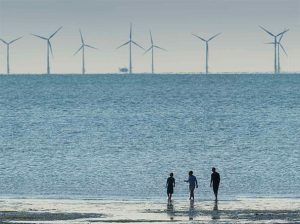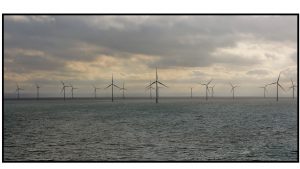The London Array is a Beacon for the Renewable Energy Movement

The London Array
The London Array Offshore Wind Farm became operational in July of 2013. It was founded by three energy companies: E.ON, DONG Energy (now Ørsted), and Masdar, with a final price tag of roughly £2 billion. Featuring 175 wind turbines, the facility produces 630 megawatts of electricity. The London Array is notable for powering half a million UK homes every year. The London Array helps to reduce harmful carbon dioxide emissions to the tune of around 900,000 metric tons CO2 avoided annually (compared to similar sized fossil fuel sources of energy generation); by supplying clean, emissions-free, climate-friendly, renewable energy - offshore wind.
 By 2015, the London Array had already set a new world record for the most energy generated by an offshore wind farm (a record that has since been eclipsed several times over, and by 2026 will be held by the U.K.'s 3.4 GW Dogger Bank Offshore Wind Farm; scheduled to be operational by 2026, although there will be energy generated by the Dogger Bank as the three separate 1.2 GW stages of the wind farm project are completed, with the first stage expected to be operational in 2023).
By 2015, the London Array had already set a new world record for the most energy generated by an offshore wind farm (a record that has since been eclipsed several times over, and by 2026 will be held by the U.K.'s 3.4 GW Dogger Bank Offshore Wind Farm; scheduled to be operational by 2026, although there will be energy generated by the Dogger Bank as the three separate 1.2 GW stages of the wind farm project are completed, with the first stage expected to be operational in 2023).
Development of the London Array
The London Array received its initial green light in 2003 when London Array Ltd. obtained a 50-year lease for the 100 km² location situated in an expansive area 20 km off the Kent coast in the outer Thames Estuary. A few years later, the onshore component of the London Array also was developed; the Cleve Hill substation.
The substation is 1 km inland from the coast in north Kent (where electricity is sent from London Array wind turbines; before being transmitted onto the U.K. grid). Cleve Hill is notable for having an extensive plan to conserve and protect the environment, people, buildings, and economy of the locality.
Offshore construction of the wind farm began in 2011, with London Array installing the first offshore wind turbine in 2012, after spending a year creating the foundation for the project. Impressively, the organization completed the installation of the additional turbines by the end of the same year.
Phase 1 of the London Array offshore wind farm was inaugurated by Prime Minister David Cameron July 4, 2013. The London Array had an detailed environmental impact report; and the London Array made a substantial conservation effort to protect and maintain the ecosystems of the ocean area the offshore wind farm inhabits.
For a wind farm, it is imperative that the site chosen receives plenty of high winds. During the over two-year-long offshore construction project, those same attributes proved to be dangerous and unpredictable in the development of the London Array.
The team of 1,000 London Array construction/ development workers and engineers persevered, and secured the wind turbines to the sea floor. The London Array development team also constructed the Cleve Hill substation to increase electricity voltage; running 450 km of cabling between the turbines and Cleve Hill, and then from the substation to the grid (which required further development of transmission lines).
Environmental considerations in London Array's Development
The development and planning for the London Array became famous for its diligence towards environmental protection, conservation, and care of the marine biodiversity of the project site. Development of the London Array was conducted in order to maintain a healthy marine ecosystem in the location of the project.
Even the Cleve Hill substation was designed with the local wildlife, as well as human habitats, in mind. The onshore Cleve Hill substation sits just one kilometer from north Kent, and features a unique design, with buildings designed to blend nearly-seamlessly with the hillside, courtesy of the RMJM architecture firm. The Cleve Hill substation connects directly to the U.K. national electricity grid.
The London Array has been proving its exceptional worth ever since it began operations in 2013. A prime example of the level of success possible when forward thinking engineers are backed by years of research and attention to detail; the London Array is a beacon for the renewable energy movement.
Please also see: Anholt Wind Farm - Denmark's Most Powerful Source of Renewable Energy
and
The Block Island Wind Farm - America's Only Operational Offshore Wind Farm